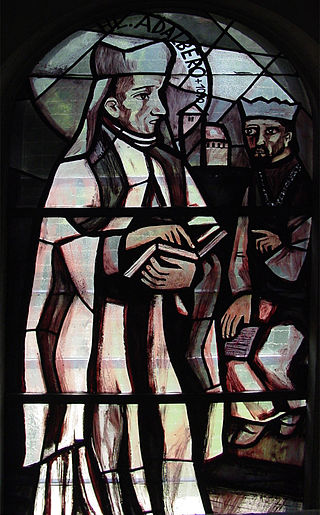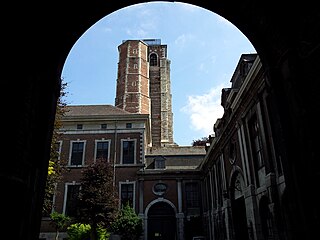Related Research Articles
Frederick I was the count of Bar and duke of Upper Lorraine. He was a son of Wigeric, count of Bidgau, also count palatine of Lorraine, and Cunigunda, and thus a sixth-generation descendant of Charlemagne.

Adalbero of Würzburg was Bishop of Würzburg and Count of Lambach-Wels.
Wideric was a Frankish nobleman and the count of the Bidgau and held the rights of a count within the city of Trier. He received also the advocacy of the Abbey of Saint Rumbold at Mechelen from Charles III, King of West Francia. From 915 or 916, he was the count palatine of Lotharingia. He was the founder of the House of Ardennes.

Gorze Abbey was a Benedictine monastery in Gorze in the present arrondissement of Metz, near Metz in Lorraine. It was prominent as the source of a monastic reform movement in the 930s.
Sigfried was Count in the Ardennes, and is known in European historiography as founder and first ruler of the Castle of Luxembourg in 963 AD, and ancestor and predecessor of the future counts and dukes of Luxembourg. He was also an advocate of the abbeys of St. Maximin in Trier and Saint Willibrord in Echternach.

Gembloux Abbey was a Benedictine abbey in Wallonia near the town of Gembloux in the province of Namur, Belgium. Since 1860, its buildings host the University of Liège's Gembloux Agro-Bio Tech faculty and campus.
WaleranII of Arlon, supposedly also called Udon of Limburg, was the count of Arlon from AD 1052 and, if he was the same person as Udon, also count of Limburg from 1065 and advocatus of the Abbey of Sint-Truiden. He was the younger son of Waleran I, Count of Arlon, and his wife Adelaide. His elder brother Fulk became Count of Arlon.
The House of Ardenne–Verdun was a branch of the House of Ardenne, one of the first documented medieval European noble families, centered on Verdun. The family dominated in the Duchy of Lotharingia (Lorraine) in the 10th and 11th centuries. All members descended from Cunigunda of France, a granddaughter of the West Frankish king Louis the Stammerer. She married twice but all or most of her children were children of her first husband, Count Palatine Wigeric of Lotharingia. The other main branches of the House of Ardennes were the House of Ardenne–Luxembourg, and the House of Ardenne–Bar.
Saint John of Gorze was a Lorraine-born monk, diplomat, administrator, and monastic reformer.

Saint Trudo was a saint of the seventh century. He is called the "Apostle of Hesbaye". His feast day is celebrated on 23 November.
Dietrichof Metz was Bishop of Metz from 964 until his death.
The Abbey of St. Evre was a Benedictine, later Cluniac, monastery in Toul, France. Established in or just before 507, it was the oldest monastery in Lorraine and of great significance in the monastic and religious reforms in the Rhine and Moselle region of the 10th and 11th centuries.
Cunigunda of Sulichgau (893-924) was the daughter of Ermentrude of France, daughter in turn of Louis the Stammerer. Her father was Eberhard of Sulichgau, son of Unruoch III. In 898 her uncle Charles III gained control as king of the Franks, changing Cunigunda's life for the better.

Sint-Truiden Abbey or St Trudo's Abbey is a former Benedictine monastery in Sint-Truiden in the province of Limburg, Belgium. The abbey was founded in the 7th century and was one of the oldest and most powerful in the Low Countries. The town of Sint-Truiden grew up around it. The great Romanesque abbey church, dedicated to Saint Remaclus and Saint Quintin, was demolished in 1798, four years after the suppression of the abbey.
Saint Guibert of Gorze is the founder of Gembloux Abbey, in Gembloux. He was canonized in 1211. Saint Guibert's Day is observed on 23 May.
The pagus or gau of Hasbania was a large early medieval territory in what is now eastern Belgium. It is now approximated by the modern French- and Dutch-speaking region called Hesbaye in French, or Haspengouw in Dutch — both being terms derived from the medieval one. Unlike many smaller pagi of the period, Hasbania apparently never corresponded to a single county. It already contained several in the 9th century. It is therefore described as a "Groẞgau", like the Pagus of Brabant, by modern German historians such as Ulrich Nonn.
The County of Duras was a medieval county with its seat at the castle of Duras. The 18th century version of this castle still stands and is a part of modern Sint-Truiden in the province of Belgian Limburg. The county was one of several counties in the Hesbaye region which covers the south of Belgian Limburg, and stretches into the neighbouring provinces. As a distinct entity under the name Duras the county only existed within the 12th century. After the first male line of counts died out, the county of Duras came by marriage to the Counts of Montaigu, whose other holdings were further south. Later they became part of the neighbouring County of Loon, which was ruled by cousins of the original counts of Duras.
Adalbero II of Metz was a Catholic bishop of the 10th and 11th centuries. From 984 until his death he was the bishop of Verdun and bishop of Metz. He was the son of Frederick I, Duke of Upper Lorraine and Beatrice of France, daughter of Hugh the Great.
The House of Luxembourg (or Luxembourg), also known as the House of Ardenne–Luxembourg in order to distinguish it from later families, were a Lotharingian noble family known from the tenth and eleventh centuries. They are one of the three main branches of the House of Ardenne, along with the House of Ardenne–Verdun, and the House of Ardenne–Bar.
References
- 1 2 Eugen Ewig (1953). "Adalbero I.Bischof von Metz (seit 929), † 962 Sankt Trond (Diözese Lüttich)". Neue Deutsche Biographie. Bayerische Staatsbibliothek, München. pp. 40–41. Retrieved 30 September 2015.
- 1 2 3 4 5 6 7 Félicien de Saulcy (1833). "Les Monnaies des évêques de metz ....Adelbéron 1er". Mémoires de l'Académie Nationale de Metz.
- ↑ "Bar Adalbero I. von: Bischof von Metz". Dr. Joachim Conrad i.A. Saarländische Biografien - PD. Archived from the original on 2012-03-27. Retrieved 30 September 2015.
- ↑ Adolf Schinzl; Alberdingk Thijm (1875). "Adelbero I.: Adalbero, seit 929 Bischof von Metz, † 26. April 964, Sohn des..." Allgemeine Deutsche Biographie (ADB) . Duncker & Humblot, Leipzig & Wikisource. pp. 143–145. Retrieved 2 October 2015.
- ↑ Kreins, Jean-Marie. Histoire du Luxembourg. Paris: Presses Universitaires de France, 2010. 5th edition.
- ↑ Véronique Gazeau; Monique Goulletpublisher=CRAHM, Université de Caen en Basse-Normandie (2008). La réforme en Lorraine. p. 105. ISBN 978-2-902685-61-5 . Retrieved 2 October 2015.
{{cite book}}:|work=ignored (help) - 1 2 3 4 5 Pierre de Ram (1866). "ADALBÉRON Ier, abbé de Saint-Trond, évêque de Metz, était fils de Vigeric ou Wideric, le premier de ..." Biographie nationale de Belgique. Académie Royale de Belgique. pp. 29–30. Retrieved 2 October 2015.